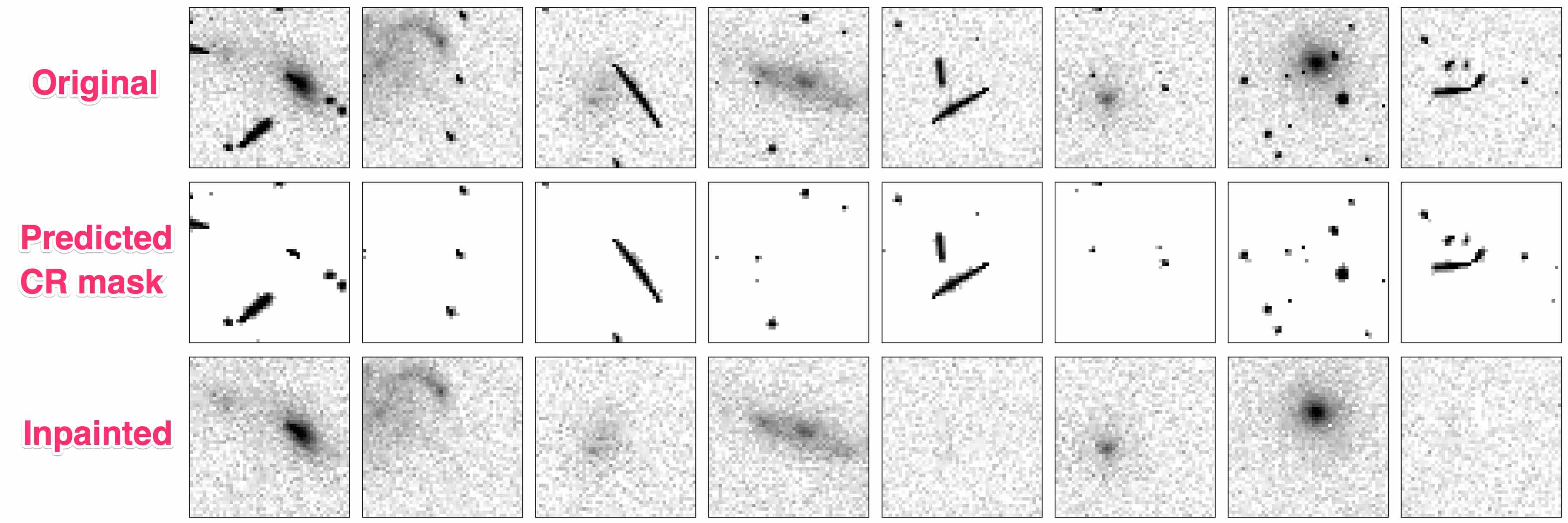No project description provided
Project description
deepCR: Deep Learning Based Cosmic Ray Removal for Astronomical Images
Identify and remove cosmic rays from astronomical images using trained convolutional neural networks.
This package is implements the method described in the paper:
deepCR: Cosmic Ray Rejection with Deep Learning
Keming Zhang & Joshua Bloom
arXiv:1907.09500; ApJ in press
If you use this package, please cite the paper above and consider including a link to this repository.

New for v0.2.0
DECam deepCR model now available!
from deepCR import deepCR
decam_model = deepCR(mask='decam', device='CPU')
Note 1: Model is trained on g-band images but is expected to work on other filters as well. We are working on benchmarking on different filters but before that's done please proceed with caution working with other filters.
Note 1: Inpainting model is TBA for DECam.
Installation
pip install deepCR
Or you can install from source:
git clone https://github.com/profjsb/deepCR.git
cd deepCR/
pip install .
Quick Start
Quick download of a HST ACS/WFC image
wget -O jdba2sooq_flc.fits https://mast.stsci.edu/api/v0.1/Download/file?uri=mast:HST/product/jdba2sooq_flc.fits
With Python >=3.5:
For smaller sized images
from deepCR import deepCR
from astropy.io import fits
image = fits.getdata("jdba2sooq_flc.fits")[:512,:512]
# create an instance of deepCR with specified model configuration
mdl = deepCR(mask="ACS-WFC-F606W-2-32",
inpaint="ACS-WFC-F606W-2-32",
device="CPU")
# apply to input image
mask, cleaned_image = mdl.clean(image, threshold = 0.5)
# best threshold is highest value that generate mask covering full extent of CR
# choose threshold by visualizing outputs.
# note that deepCR-inpaint would overestimate if mask does not fully cover CR.
# if you only need CR mask you may skip image inpainting for shorter runtime
mask = mdl.clean(image, threshold = 0.5, inpaint=False)
# if you want probabilistic cosmic ray mask instead of binary mask
prob_mask = mdl.clean(image, binary=False)
For WFC full size images (4k * 2k), you should specify segment = True to tell deepCR to segment the input image into 256*256 patches, and process one patch at a time. Otherwise this would take up > 10gb memory. We recommended you use segment = True for images larger than 1k * 1k on CPU. GPU memory limits may be more strict.
image = fits.getdata("jdba2sooq_flc.fits")
mask, cleaned_image = mdl.clean(image, threshold = 0.5, segment = True)
(CPU only) In place of segment = True, you can also specify parallel = True and invoke the multi-threaded version of segment mode. This will speed things up. You don't have to specify segment = True again.
image = fits.getdata("jdba2sooq_flc.fits")
mask, cleaned_image = mdl.clean(image, threshold = 0.5, parallel = True, n_jobs=-1)
n_jobs=-1 makes use of all your CPU cores.
Note that this won't speed things up if you're using GPU!
Contributing
We are very interested in getting bug fixes, new functionality, and new trained models from the community (especially for ground-based imaging and spectroscopy). Please fork this repo and issue a PR with your changes. It will be especially helpful if you add some tests for your changes.
Project details
Release history Release notifications | RSS feed
Download files
Download the file for your platform. If you're not sure which to choose, learn more about installing packages.

















